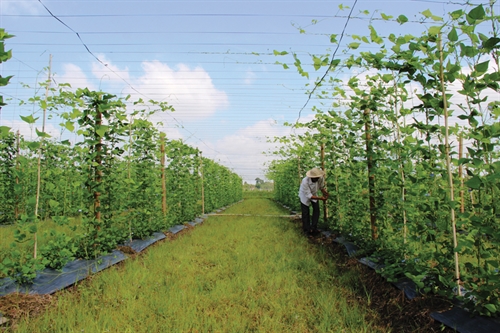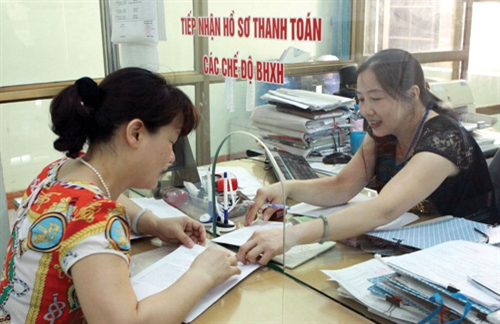In Duong Lam, an old village in Son Tay town just 50 km west of Hanoi, having a son is almost a responsibility toward the family line every couple must shoulder.
Kieu Thi L. has given birth six times to have a son since her husband is a family line head who is burdened with the duty of maintaining the continuance of his clan. L. and her husband have no choice but have a boy to fulfill their obligation as in Duong Lam, no excuse for not having a son will be accepted for a family line head.
There are many women like L. in Duong Lam who desperately try for a son under hard pressure from their husbands and clans, making the village one of the leading localities in Hanoi reporting a high sex ratio at birth. Of 650 children going to Duong Lam kindergarten, only 275 or 42 percent are girls.
Do Viet Hung, director of the Son Tay Population and Family Planning Center gave shocking statistics about the gender imbalance in this town. Since 2003, the sex at birth ratio imbalance in Son Tay has constantly risen, now hitting 131, which means there are 131 boys born for every 100 girls. The highest rate is recorded in some villages like Trung Son Tram with 180; Duong Lam and Song Dong, 178; Le Loi, 142; and Quang Trung, 131. The rate of third births has also been high in Son Tay for the last few years, reaching 11.3 percent in 2012 with Duong Lam topping 24 percent.
Unfortunately, Son Tay is not the only locality reporting a high sex ratio at birth. Hanoi’s other suburban areas and provinces and cities nationwide are also encountering the same problem.
According to statistics of the General Office of Population and Planning, the country’s sex ratio at birth remained high after a national plan to control gender imbalance at birth for 2016-2025 was launched last year. Vietnam’s sex ratio at birth was reported at 112.2 in 2016, a slight decrease from 112.8 in 2015 but still higher than 111.2 in 2014.
Specialized population statistics also showed that 45 provinces and cities nationwide reported an alarmingly rising sex ratio at birth which topped 115 boys/100 girls, the Thanh Nien (Young People) daily reported. This ratio was highest in ten provinces and cities, namely Hung Yen, Hai Duong, Bac Ninh, Bac Giang, Nam Dinh, Hoa Binh, Hai Phong, Vinh Phuc, Quang Ninh and Quang Ngai, some of which registered a record high of 120. Hanoi also reported a soaring 114.5 as compared with the national average, with some districts hitting 120, the municipal Population and Family Planning Sub-Department reported.
According to statistics of the Population and Labor Statistics Department under the General Statistics Office, the Red River Delta remained the region recording the highest sex ratio at birth, which had steadily risen for five years in a row, from 115.3 in 2009 to 118 in 2014.
Notably, the male-to-female birth ratio surged accordingly with women’s educational levels, from between 106 and 111 in the group of mothers graduating primary school, to 113 in women of high school education and 115 in those of higher education, the Population and Labor Statistics Department reported.
According to the United Nations Population Fund (UNFPA), the natural sex ratio at birth ranges between 102 and 106 boys/100 girls and any higher ratio shows signs of sex selection. A higher ratio in second and third births has also been observed in Vietnam.
Addressing a seminar held in late May in Vinh Phuc province to review the one-year implementation of the national plan to control gender imbalance for 2016-2025, Deputy Minister of Health Nguyen Viet Tien acknowledged the imbalance of sex ratios at birth was growing speedily, widely and seriously, particularly in Red River Delta provinces.
Without prompt and effective intervention to this imbalance, between 2.3-4 million Vietnamese men would not be able to find a wife by 2050, experts estimated.
Experts attributed the imbalance mostly to sex selection at birth as a result of gender prejudice. Preference for boys and undervaluation of girls have deeply rooted in cultural values under the influence of Confucianism which grants higher social respect to men as they are considered the continuance of family lines and must take care of graves of family ancestors. Sons are also supposed to live with and look after their parents who mostly will feel uncomfortable living with daughters as they are regarded as children of other families once they get married.
The toughest challenge for the advocacy of non-selection of sex at birth was the must to have a son, which has deeply rooted in the mind of people here, said Ha Minh Diep, a commune officer in charge of family planning in Duong Lam village.
A family should have both sons and daughters like a tree must have root and branches, said Nguyen Van Vinh, an old man in Ba Vi suburban district of Hanoi, adding he had asked his oldest son and daughter-in-law who had two daughters to give birth to a third child even though he knew the couple would have more burden to shoulder.
Vinh’s thinking, which was common, especially in rural areas, explained the sex ratio imbalance in third births.
Despite an official ban on selection of sex at birth, ultrasonic and abortion services have been provided for this purpose without being sanctioned since it was difficult to detect violations, population officials said.
It was not that easy to punish health establishments violating this ban without explicit evidence which could hardly be collected as there were many ways to let a mother know her future baby’s sex without having to tell her straightly, said Ta Quang Huy, director of Hanoi Population and Family Planning Department, adding the sanction also appeared not strict enough to prevent sex-selective abortions.
Although identification of the gender of fetus was illegal, this practice was common in reality, said Nguyen Van Tan, deputy director of the General Department of Population and Family, citing some 81 percent of mothers knowing their babies’ sex before birth.
The gender imbalance would seriously impact the country’s socio-economic development as well as the life of women, men, families and communities, experts said. A shortage of women would make it difficult for men to find a wife and likely to have to stay single, which would lead to social consequences, including rising gender inequality, women’s early marriage, re-marriage and divorce, increases in prostitution, trafficking of women and children and violence against women, social unrests as a result of men’s social and sexual dissatisfaction and shortage of labor in particular occupations such as preschool or primary school teacher and nurse.
Experts agreed to tackle the problem in the long run, it was crucial to eliminate gender inequality and undervaluation of women - the very cause of gender imbalance, to ensure the rights of women who should have equal opportunities with men in all aspects of life.- (VLLF)









